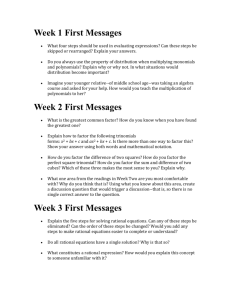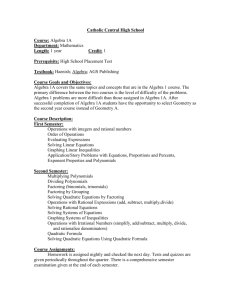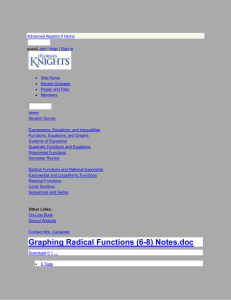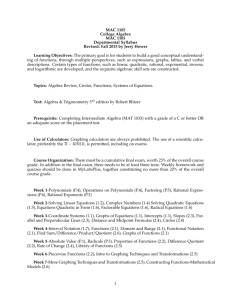Fundamentals of Algebra II - Portal
advertisement
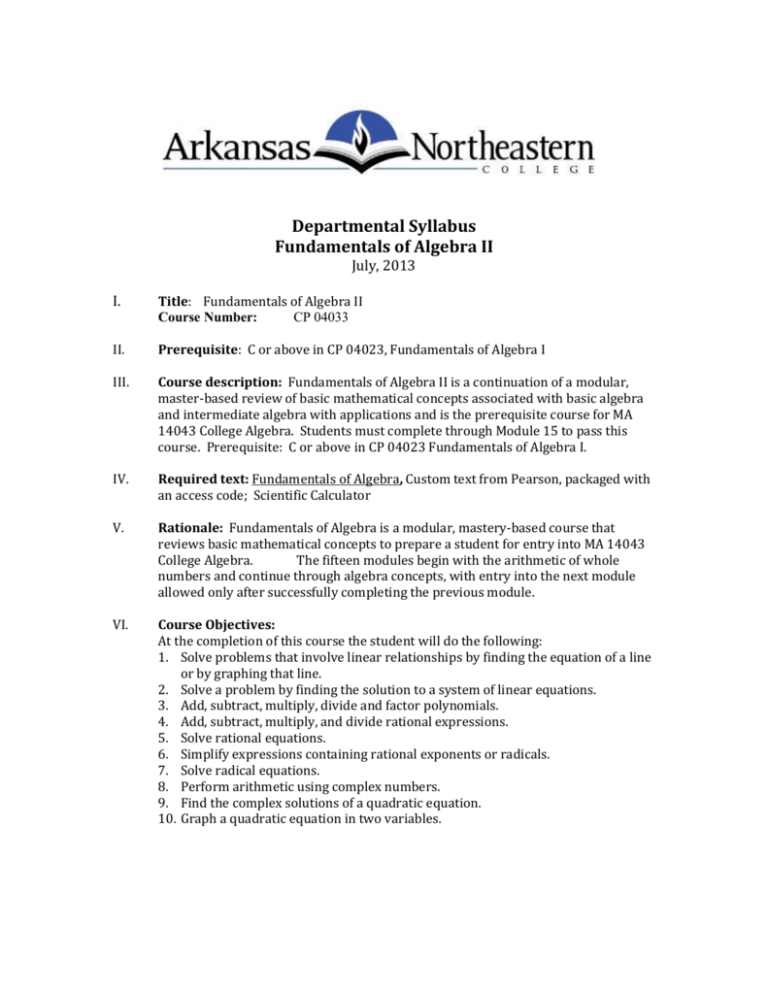
Departmental Syllabus Fundamentals of Algebra II July, 2013 I. Title: Fundamentals of Algebra II Course Number: CP 04033 II. Prerequisite: C or above in CP 04023, Fundamentals of Algebra I III. Course description: Fundamentals of Algebra II is a continuation of a modular, master-based review of basic mathematical concepts associated with basic algebra and intermediate algebra with applications and is the prerequisite course for MA 14043 College Algebra. Students must complete through Module 15 to pass this course. Prerequisite: C or above in CP 04023 Fundamentals of Algebra I. IV. Required text: Fundamentals of Algebra, Custom text from Pearson, packaged with an access code; Scientific Calculator V. Rationale: Fundamentals of Algebra is a modular, mastery-based course that reviews basic mathematical concepts to prepare a student for entry into MA 14043 College Algebra. The fifteen modules begin with the arithmetic of whole numbers and continue through algebra concepts, with entry into the next module allowed only after successfully completing the previous module. VI. Course Objectives: At the completion of this course the student will do the following: 1. Solve problems that involve linear relationships by finding the equation of a line or by graphing that line. 2. Solve a problem by finding the solution to a system of linear equations. 3. Add, subtract, multiply, divide and factor polynomials. 4. Add, subtract, multiply, and divide rational expressions. 5. Solve rational equations. 6. Simplify expressions containing rational exponents or radicals. 7. Solve radical equations. 8. Perform arithmetic using complex numbers. 9. Find the complex solutions of a quadratic equation. 10. Graph a quadratic equation in two variables. VII. Topical/Module Outline Module 10: Solving systems of linear equations. Module 11: Arithmetic of polynomials. Module 12: Factoring polynomials. Module 13: Rational expressions and rational equations. Module 14: Arithmetic using radicals and complex numbers. Module 15: Solving quadratic equations and applications. VIII. Unit Objectives: A. Module 10: Solving systems of linear equations. Rationale: In this module, you will begin the study of functions. Also, solving linear inequalities and linear systems of equations will be presented, along with applications problems. At the conclusion of this unit, the student will do the following: 1. Given the graph of a relation, determine if it is a function. 2. Given a set of ordered pairs, determine if it represents a function. 3. Given the graph of a function, determine the domain and range of the function. 4. Given the formula for a function, determine the domain and range. 5. Using function notation, evaluate the function. 6. Given a linear inequality in two variables, graph the solution set. 7. Solve applied problems involving direct or inverse variation. 8. Solve a system of linear equations by graphing. 9. Solve a system of linear equations by substitution. 10. Solve a system of linear equations by addition. 11. Solve applied problems by setting up a system to model the problem and then solve the system to find the answer. B. Module 11: Arithmetic of polynomials. Rationale: Polynomials can be used to model many real-world phenomena. In this module, you will learn to do arithmetic using polynomials. At the conclusion of this unit, the student will do the following: 1. 2. 3. 4. Use the rules for exponents to multiply or divide monomials. Use the rules for exponents to raise a monomial to a power. Calculate a number raised to a negative power. Use the rules for exponents to simplify an expression, making sure to use only positive exponents. 5. Change a number in scientific notation to standard form. 6. Given a number in standard form, write it in scientific notation. 7. Simplify an expression by combining like terms. 8. Add and subtract polynomials by removing parentheses and combining like terms. 9. Multiply two polynomials. 10. Find the product when a binomial is squared. 11. Find the product when multiplying the sum and difference of two terms. 12. Find the quotient when dividing a polynomial by a single term. 13. Use long division to divide a polynomial by a polynomial. C. Module 12: Factoring polynomials. Rationale: Factoring allows us to write a sum as a product. Factoring can be used to solve equations other than linear equations. It can also be used to simplify and perform arithmetic on rational expressions (module 13). At the conclusion of this unit, the student will do the following: 1. 2. 3. 4. 5. 6. 7. 8. Given a polynomial, factor out the greatest common factor. Given a four-term polynomial, factor it by grouping. Factor a trinomial of the form 𝑥 2 + 𝑏𝑥 + 𝑐 completely. Factor a trinomial of the form 𝑎𝑥 2 + 𝑏𝑥 + 𝑐 completely. Factor perfect square trinomials completely. Factor the difference of two squares completely. Factor the sum of two cubes completely. Factor the difference of two cubes completely. D. Module 13: Rational expressions and rational equations. Rationale: In this module, we will perform arithmetic using algebraic fractions. We will employ the same principles used with arithmetic fractions to add, subtract, multiply and divide these rational expressions. At the conclusion of this unit, the student will do the following: 1. Simplify a rational expression by factoring the numerator and denominator and canceling common factors. 2. Find the product of two or more rational expressions and express the result in lowest terms. 3. Find the quotient of two rational expressions and express the result in lowest terms. 4. Use a conversion factor to convert between units of measure. 5. Solve an applied problem by converting units. 6. Find the least common denominator for two rational expressions. 7. Rewrite a rational expression as an equivalent expression whose denominator is the least common denominator. 8. Add or subtract rational expressions. 9. Solve rational equations. 10. Solve applications problems involving rational equations. 11. Simplify complex fractions. E. Module 14: Arithmetic using radicals and complex numbers. Rationale: This module begins with rational exponents and radicals and then concludes with the set of complex numbers and the arithmetic of those numbers. At the conclusion of this unit, the student will do the following: 1. 2. 3. 4. 5. 6. 7. 8. 9. 10. 11. 12. 13. 14. 15. 16. Find the nth root of a term. Find the nth root of a fraction. Given a radical function, evaluate that function for a given input value. Rewrite a number raised to a rational exponent using radical notation. Given an algebraic expression having rational exponents, use the properties of exponents to simplify the expression, writing the result with only positive exponents. Use the rules of radicals to compute and simplify radical expressions. Given two points, use the Distance Formula to find the distance between those two points. Write the answer in reduced radical form. Add and subtract like radicals. Rationalize denominators of radical expressions. Rationalize numerators of radical expressions. Solve equations containing radicals. Simplify square roots of negative numbers. Add or subtract complex numbers, writing the result in the form a+bi. Multiply complex numbers, writing the result in the form a+bi. Divide complex numbers, writing the result in the form a+bi. Calculate powers of 𝑖. F. Module 15: Solving quadratic equations and applications. Rationale: Quadratic equations are used to model and solve many types of problems. In this module, you will learn several different methods of solving these equations. At the conclusion of this unit, the student will do the following: 1. 2. 3. 4. 5. 6. 7. 8. Solve certain quadratic equations by using the Square Root Property. Solve certain quadratic equations by factoring. Solve a quadratic equation by completing the square. Solve a quadratic equation by using the quadratic formula in which some of the solutions will be non-real, complex. Use the discriminant to determine the number and nature of the roots of a quadratic equation. Solve applied problems that are modeled by a quadratic equation by first setting up the equation and then solving it. Solve nonlinear inequalities in one variable and write the answer using interval notation. Given a quadratic function, find its vertex, intercepts, and axis of symmetry. Using this information, graph the quadratic. IX. Course policies: Grades Students will continue with the next assignment in the module sequence. A student has the opportunity to test out of each module by successfully completing the pretest for that module. If a student does not successfully complete the pretest, then homework sets will be completed, quizzes completed, and notebook items will be completed and a Practice Exam. Students must score an 80% or above on the Practice Exam for entry into the Module Exam. Students will have two chances to take the Module Exam, with the higher of the two grades being used to calculate the final course grade. Practice Exam scores will not be used to calculate the final course grade. Mastery will be determined by the following percentage grades on pretests, homework, and posttests: Pretests (proctored): 80% or higher on a pretest will allow a student to advance to the next module’s pretest. If a student scores 80% or higher on a pretest, he/she will skip to the next module. Pretests will not be counted in the grade. Homework: Students must score 90% or higher on a homework assignment to advance to the next homework assignment, quiz, or exam. All homework must be mastered before a student will be allowed to take the exam for a module. The homework average will be used to calculate the final course grade. Quizzes (not proctored): After completing several homework sets with a 90% or above, students will be required to complete a quiz over those sections. Students will have two chances to complete the quizzes, with the higher of the two grades used to calculate the final course grade. Practice Exams (not proctored): Students must score an 80% or higher on the practice exam to move to the module exam. Practice exam scores will not be used to calculate the final course grade. All notebook assignments must be completed before taking the Practice Exam. Module Exams (proctored): Students will have two chances to take the Module Exams. The higher of the two scores will be used to calculate the final course grade. Notebook: Notebook pages will be posted on the portal or available in class. Download these pages for each module and complete them before taking the Practice Exam. Notebook pages must be checked by the instructor or lab personnel. Final Exam (proctored): The final exam will be comprehensive over Modules 9 through 15. Students will have two chances to take the final exam. The higher of the two grades will be used to calculate the final course grade. Calculation of course grades: The course grade will be calculated using the following percentages: Homework Quizzes Modules Exams Final Exam 15% 105% 50% 20% The grading scale is as follows: 90-100% 80-89% 70-79% 60-69% 0-59% A^ B^ C^ D^ F (A^, B^, C^, and D^ are not used in calculating the grade point average.) (Counts in the grade point average.) If all required modules are not completed, the student will receive a grade of F, but will begin the next semester continuing on with the next module assignment in the sequence. If a student skips a semester, he/she must begin in Module 1 again. A student may withdraw from the course and receive a grade of W then re-enroll the next semester and continue on in the sequence of modules. X. Course Policies: How-To Guides To progress through each Module, refer to the following Guide: FAST TRACK Mathematics How-to Chart STEP 1: Complete Module Pretest (Proctored by lab personnel) If Score < 80% ⇩ Read section in text ⇩ Go to MyMathLab and Complete homework With scores ≥ 90%⇨See “MyMathLab Chart” ⇩ Complete Quizzes Can be taken only twice ⇩ Complete Practice Exam With score of 80% or above Not proctored; may be taken many times ⇩ Complete Notebook pages For Module (Checked by lab Personnel) ⇩ Complete Module Exam If not satisfied with score, may Take one more time. Proctored; Can be taken only twice ⇩ Go to next Module Pretest (Proctored by lab Personnel) And repeat process. If Score ≥ 80% ⇩ Congratulations! ⇩ Go to next Module Pretest (Proctored by lab personnel) To progress through MyMathLab, use the following Guide: FAST TRACK Mathematics MyMathLab How-to Chart View Media Assignments (Videos, Power Point slides) Can be done anywhere there is internet access ⇩ Complete HW set with score ≥ 90% Can be done anywhere there is internet access ⇩ Go to next HW set only after attaining score ≥ 90% On previous HW set Can be done anywhere there is internet access ⇩ Complete any Quizzes listed in MyLabsPlus Not Proctored; Can be taken only twice ⇩ Complete Module Practice Exam (NotProctored) Can be completed anywhere there is internet access ⇩ If score ≥ 80% ⇩ Complete Notebook Checked by lab personnel ⇩ Go to Module Exam ⇩ If score < 80% ⇩ Complete generated HW ⇩ Re-take Practice Exam Must be completed in the lab Module Exam may be taken twice. NOTE: Students will have two chances to take the Module Exam. The higher of the two grades will be recorded in the grade book and used to calculate the final course grade. XI. Course Policies: Pacing To be on track to finish Modules 9 through 15, refer to the following tables. Milestones End of week… Mod 3 10 7 12 12 14 Last Day of Class Practice Final Instructors must monitor students’ progress through the modules. If a student is not progressing at an acceptable rate, then the student may be required to spend more hours in the lab or on the homework. Instructors will check on the progress of their students weekly. At the end of the week for which there is a milestone, students will receive grades of zero for any unopened homework sets. Students will be able to work those homework sets and replace the zero with a higher score. If a student has reached a milestone, bonus points will be awarded to the exam over that module listed in the chart above. If a student does not complete all modules, then a grade of F will be assigned. The student will begin the next semester, though, continuing on in the module sequence. If a student skips a semester, he/she must begin with Module 10 when re-enrolling in Fundamentals of Algebra II. Midterm grades: Midterm grades will be assigned based on the table above and the modules completed by the student. If a student is on track at week 7 (see Milestones table), then the midterm grade will be calculated using homework, Module Exams, quizzes, and attendance grades. If a student is not on track but making progress, he/she will receive a D^ at midterm. If a student is not making progress through the modules, he/she will receive an F at midterm. XII. Course Policies: Technology and Media Email: Arkansas Northeastern College has partnered with Google to host email addresses for ANC students. myANCmail accounts are created for each student enrolled in the current semester and is the email address your instructor will use to communicate with you. Access your email account by going to http://mail.google.com/a/smail.anc.edu and using your first and last names, separated by a period for your username. Your default password is your Student ID, no hyphens. If you cannot access your student email, contact the MITS department at 762-1020 ext 1150 or ext 1207 or send an email to ANChelp@smail.anc.edu. Internet: This course has a web component on myANC. Computer Labs: In addition to general-purpose classrooms, a number of computer laboratories are provided for instructional and student use. These networked laboratories are state-of-the-art and fully equipped with computers, printers, Internet connections and the latest software. The labs are open to students enrolled in one or more credit hours at the College. Technology Support: A lab assistant is generally present in the computer lab in B202 for assistance in using the College computers. These assistants cannot help you with course assignments; specific questions regarding the technology requirements for each course should be directed to the instructor of the course. Problems with myANC or College email accounts should be addressed by email to ANCHelp@smail.anc.edu. XIII. Course Policies: Student Expectations Disability Access: Arkansas Northeastern College is committed to providing reasonable accommodations for all persons with disabilities. This First Day Handout is available in alternate formats upon request. Students with disabilities who need accommodations in this course must contact the instructor at the beginning of the semester to discuss needed accommodations. No accommodations will be provided until the student has met with the instructor to request accommodations. Students who need accommodations must be registered with Johnny Moore in Statehouse Hall, 762-3180. Professionalism Policy: Per classroom etiquette; mobile phones, iPods, etc. must be silenced during all classroom and lab lectures. Those not heeding this rule will be asked to leave the classroom/lab immediately so as to not disrupt the learning environment. Please arrive on time for all class meetings. Academic Integrity Policy: Academic dishonesty in any form will not be tolerated. Students are expected to do their own work. Plagiarism, using the words of others without express permission or proper citation, will not be tolerated. Any cheating (giving or receiving) or other dishonest activity will, at a minimum, result in a zero on that test or assignment and may be referred, at the discretion of the instructor, to the Department Chair and/or Chief Academic Officer for further action. If you are uncertain as to what constitutes academic dishonesty, please consult the Academic Integrity Policy for further details. (http://www.anc.edu/docs/Academic_Integrity_Policy.pdf) Working together on homework assignments is allowed and can be done anywhere there is an internet connection and a computer. Pretests and Module Exams must be proctored by Math lab personnel in the classroom (C103) or the lab (L105 or L107). Copying another student’s Notebook pages will be considered cheating. What constitutes cheating in this course? ●Talking while you are taking a pretest or posttest ●Talking to another student while he/she is taking a pretest or posttest ●Using a calculator on homework, pretests, or posttests for Modules 1, 2, or 3 ●Copying another student’s notebook pages or allowing a student to copy your notebook pages ●Having your text book open or your notes open during a pretest or posttest ●Having your cell phone on the desk while taking a pretest or posttest. What will be the consequences of not following the Academic Integrity Policy? ●For the first infraction, a student will receive a grade of zero on that pretest or posttest. If it was a pretest, the student must then complete all the homework sections in that module. If it was a posttest, the student will receive a zero in the grade book, but must still pass the posttest with an 80% or above to proceed to the next module. That student’s name will be reported to the appropriate Dean. (See Academic Integrity Policy). ●For the second infraction, the student will receive a failing grade for the course and must meet with the Dean and/or the Chief Academic Officer to determine any other appropriate actions necessary. Academic & Career Enrichment Advising Center: The Academic & Career Enrichment (ACE) Advising Center is located in Statehouse Hall in Room S145. The ACE Advising Center advises all new ANC students. Once a student has begun progressing through his/her program of study the student will be assigned an advisor in the field of study. Prospective students are provided test prep assistance through the computerized Skills Tutor system for Compass test placement. The ACE Advising Center also houses a Virtual Career Center including career placement services, as well as academic tutoring services for enrolled students. The tutoring services offered are oneon-one tutoring, group tutoring, and group labs for specific classes. Other Student Support Services: Many departments are ready to assist you reach your educational goals. Be sure to check with your advisor; the ACE Advising Center, Room S145 and Student Support Services, Room W207; to find the right type of support for you. Disclaimer: This First Day Handout was prepared under certain limited assumptions. Therefore, if the students in the class seem to "fit" the design for the course and if events occur as planned, the schedule, assignments, and assessments will be followed. The instructor has the option, however, to eliminate or add assignments and/or assessments if he/she feels it is in the best interest of the students.

